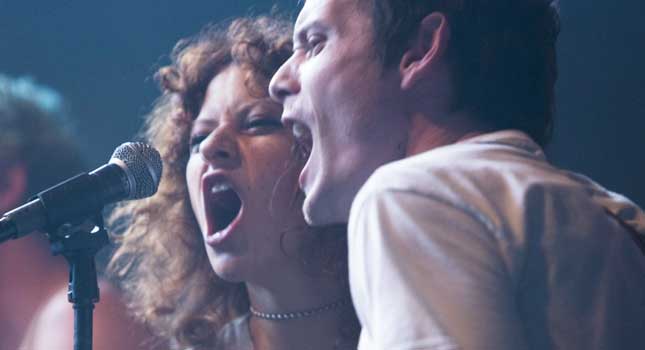By Max Levine
Okay, let me start off with a warning: Don’t go on a first date to Green Room. Go on a last date to Green Room. If you are having a day where your stomach is upset and you just ate three consecutive bowls of New England Clam Chowder, maybe don’t see Green Room. Be in a state of mind where you can be okay with the worst things happening in Jeremy Saulnier’s third feature film.
Green Room chronicles the journey of The Ain’t Rights, an East Coast-based punk band struggling to find paying gigs to help fund their road trip. They spend their time siphoning gas from other cars, telling shitty jokes, and playing shows that aren’t too fruitful. They end up booked at a bar in the middle of the woods outside of Portland. Once they arrive, they discover that the bar is a hub for neo-Nazis. After leaving their belongings in the green room in the back of the bar, they play their set, and it goes well enough. Afterwards, one of the band members, Pat (Anton Yelchin) goes into the green room to grab a bandmate’s cell phone. When he discovers a dead girl lying on the floor, he panics and runs out of the room, attempting to phone the police. The neo-Nazis in the green room then force him, the rest of the bandmates, and the dead woman’s close friend, Amber (Imogen Poots) to stay put until they can figure out what to do with them. They all, however, have a pretty clear idea of the inevitable. And from there, it becomes a couple different genres of movie: escape thriller, horror, action. And it is awesome. But between those evolutions, it’s also just goddamn grotesque. It’s the kind of movie where you and everyone around you can’t help but scream the worst profanities in the theater out of sheer shock.
Jeremy Saulnier likes blood. If you saw his breakout film, Blue Ruin in 2013, you know this already. Each kill or action in Blue Ruin is uniquely surprising, but it’s unique in how real it looks, how closely you’re connected to the character who has committed this act, and you get a sense of Saulnier’s personal aesthetic from it—this almost cartoonish, yet remarkably uncanny violence.
But where Blue Ruin is precise and a little more calculated in its bloodlust, Green Room is far, far less so. It’s messy, and proud of its mess. It is as raw as raw gets. Things happen—but they astound you in their happening. One moment a character will tell you about their surefire escape method, and not ten seconds later, there is just a gaping shotgun hole where that character’s face used to be. There is more exploding viscera, guts and gore—anything you can imagine in the most hyperreal and tangible form—than any sort of thriller or horror movie in recent memory. It’s definitely hard to stomach, not even “at times.” To wit: something happens to a character’s arm in the first half hour that is hands down the most repulsive-looking special effects work I have ever seen done to a limb on film—take that for what you will.
But that isn’t necessarily a bad thing! While subtlety is not in the Green Room’s nature, it makes up for it in a lot of other ways. There’s a prickly, never-knowing-what’s-going-to-be-around-the-corner feeling that encompasses every second of the film helping to justify the hyperviolence. It doesn’t keep the audience guessing; it forces the audience to think with the characters in terms of survival—with limited resources and strategies. Amber and Darcy, the neo-Nazi gang’s leader, portrayed by Patrick Stewart, are really the two stand-out characters in the film. Poots’s character is sort of this cold-blooded John McClane-esque pseudo-nihilist punk, who has a diminutive sense of humor while also maintaining a commanding presence in the most integral moments. Stewart’s antagonist persona is not as intense as one might expect, but he’s malicious in a manner that only Saulnier could conduct —like the color scheme of the film itself: green; toxic. He emits a highly foreboding and uncharacteristic sadism you wouldn’t attribute to the captain of the Enterprise.
The performances from the ensemble cast are not particularly different from any traditional slasher movie. A lot of screaming, yelling and “We are getting THE FUCK out of here, man.” But they don’t really need to have much dimension—there isn’t even enough time to establish anything like that—we just want them to get the hell out of that neo-Nazi hellhole. They’re escaping pure malevolence and living, alone, is a sufficient motive.
Blue Ruin was masterful in its application of composition, and Green Room is no different. Blue Ruin was expansive and traveled many places, but Green Room is a wonderful, haunting microcosm. Almost every shot has purpose, gravity, and spatial ambiguity. I’m not sure what’s with his obsession with color grading everything to fit a certain tone, but there’s a radical sort of finesse he brings to it that is definitely worthy of some level of praise. I’m certainly down for “Orange Rental Car” or whatever comes next in Saulnier’s violent chromatic lineup, but I’m probably going to need a barf bag.
Green Room is now playing.
Max Levine is a video editor at ATB Productions in Baltimore. Sometimes performs stand-up depending on how nervous he gets. Occasionally writes for Baltimore City Paper.



